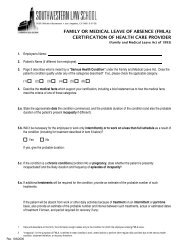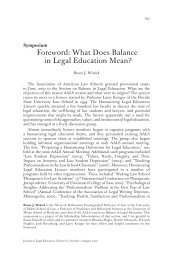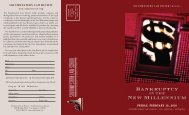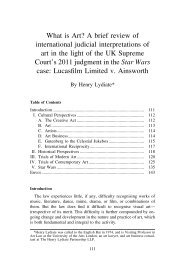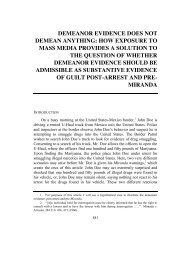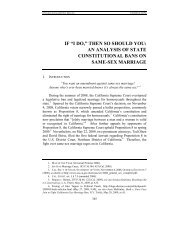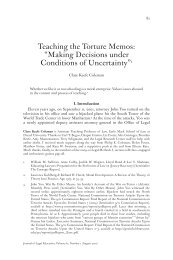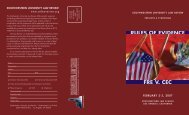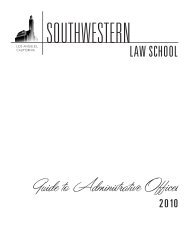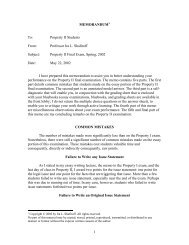An Autobiography of a Digital Idea - Southwestern Law School
An Autobiography of a Digital Idea - Southwestern Law School
An Autobiography of a Digital Idea - Southwestern Law School
You also want an ePaper? Increase the reach of your titles
YUMPU automatically turns print PDFs into web optimized ePapers that Google loves.
488 Journal <strong>of</strong> Legal Education<br />
tools. At the time, PowerPoint was the new, exciting technology. However, when<br />
I used PowerPoint, I found that my students actually became less engaged in<br />
class as they sat back and passively watched a slide show instead <strong>of</strong> sitting up<br />
and becoming engrossed in the materials. While my slides might have helped<br />
the visual learners in the class and lifted some eyes <strong>of</strong>f their laptops, they did<br />
nothing to engage the digital learner. 13 At this point I realized I was using<br />
technological devices ineffectively as “bells and whistles” 14 instead <strong>of</strong> creating<br />
an environment to keep students engaged and improve their understanding<br />
<strong>of</strong> the materials. Therefore, I began researching the ways in which digital<br />
students think so that I could use the new technology effectively to better<br />
reach them in the classroom. 15<br />
III. The <strong>Digital</strong> <strong>Law</strong> Student<br />
In my research and experimentation, I found that digital-age students think<br />
and learn much differently from previous generations. First, they learn best<br />
from three-dimensional, discovery-based learning. Second, they can multitask<br />
and telescope, gathering information quickly from a variety <strong>of</strong> sources. Third,<br />
digital students need to be “powered up” to learn. In addition, they benefit<br />
from peer review and interaction in a collaborative environment—more so<br />
than other generations. Finally, they crave immediate feedback and demand<br />
convenience.<br />
A. Three-Dimensional, Discovery-Based Learning<br />
First, while most pr<strong>of</strong>essors think in linear fashion, moving from broad<br />
category to narrower categories usually in a page-by-page textual format,<br />
digital students think more three-dimensionally, moving from one screen to the<br />
next on the computer without regard for context. 16 While a traditional learner<br />
(such as a pr<strong>of</strong>essor) might need to enter a text at the beginning, a digital<br />
learner can enter at any location and exit at any time. Hyperlinks make this<br />
13. Other pr<strong>of</strong>essors have come to the same conclusions. See Alison Sulentic, PowerPoint and<br />
the Power Nap: Adventures in PowerPoint, Gonz. Univ./Inst. For <strong>Law</strong> Sch. Teaching<br />
(Spokane, Wash. 1999); Douglas L. Leslie, How Not to Teach Contracts and any Other<br />
Course: PowerPoint, Laptops, and the Case File Method, 44 St. Louis U. L.J. 1289, 1304–<br />
1306 (2000); see also Joel Forman, Next-Generation Educational Technology versus the<br />
Lecture, Educause 12 ( 2003) (PowerPoint slides are weak in relation to the visual standards<br />
set by pr<strong>of</strong>essional image makers in the television, film, video-gaming, and advertising<br />
industries).<br />
14. Caron & Gely, supra note 3, at 551.<br />
15. Diana R. Donahoe, Teachinglaw.com, Bridging the <strong>Digital</strong> Divide, 5 Va. J.L. & Tech. 13<br />
(2000). In this article, I compared the differences between the ways in which most law<br />
school pr<strong>of</strong>essors think with the ways in which most <strong>of</strong> our students think. I also suggested<br />
ways for pr<strong>of</strong>essors to bridge the digital divide to reach their students in the classroom,<br />
including the need for pr<strong>of</strong>essors to write interactive, multimedia casebooks to use in their<br />
classes.<br />
16. Id.



